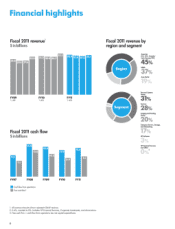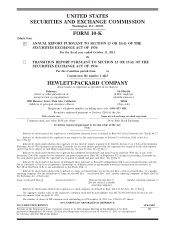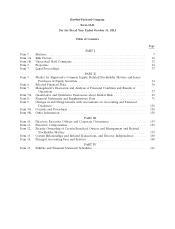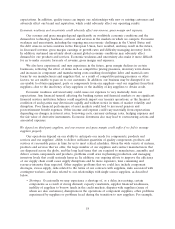HP 2011 Annual Report Download - page 18
Download and view the complete annual report
Please find page 18 of the 2011 HP annual report below. You can navigate through the pages in the report by either clicking on the pages listed below, or by using the keyword search tool below to find specific information within the annual report.competitive position. At October 31, 2011, our worldwide patent portfolio included over 36,000 patents,
which represents a slight decrease over the number of patents in our patent portfolio at the end of
fiscal 2010 but an increase over the number of patents in our patent portfolio at the end of fiscal 2009.
Patents generally have a term of twenty years from the time they are filed. As our patent portfolio
has been built over time, the remaining terms on the individual patents vary. We believe that our
patents and applications are important for maintaining the competitive differentiation of our products
and services, enhancing our ability to access technology of third parties, and maximizing our return on
research and development investments. No single patent is in itself essential to us as a whole or any of
our principal business segments.
In addition to developing our patents, we license intellectual property from third parties as we
deem appropriate. We have also granted and continue to grant to others licenses under patents owned
by us when we consider these arrangements to be in our interest. These license arrangements include a
number of cross-licenses with third parties.
For a discussion of risks attendant to intellectual property rights, see ‘‘Risk Factors—Our revenue,
cost of sales, and expenses may suffer if we cannot continue to license or enforce the intellectual
property rights on which our businesses depend or if third parties assert that we violate their
intellectual property rights,’’ in Item 1A, which is incorporated herein by reference.
Backlog
We believe that backlog is not a meaningful indicator of future business prospects due to the
diversity of our products and services portfolio, including the large volume of products delivered from
shelf or channel partner inventories and the shortening of product life cycles. Therefore, we believe
that backlog information is not material to an understanding of our overall business.
Seasonality
General economic conditions have an impact on our business and financial results. From time to
time, the markets in which we sell our products experience weak economic conditions that may
negatively affect sales. We experience some seasonal trends in the sale of our products and services.
For example, European sales often are weaker in the summer months and consumer sales often are
stronger in the fourth calendar quarter. Demand during the spring and early summer months also may
be adversely impacted by market anticipation of seasonal trends. See ‘‘Risk Factors—Our sales cycle
makes planning and inventory management difficult and future financial results less predictable,’’ in
Item 1A, which is incorporated herein by reference.
Competition
We encounter aggressive competition in all areas of our business activity. We compete primarily on
the basis of technology, performance, price, quality, reliability, brand, reputation, distribution, range of
products and services, ease of use of our products, account relationships, customer training, service and
support, and security.
The markets for each of our business segments are characterized by vigorous competition among
major corporations with long-established positions and a large number of new and rapidly growing
firms. Product life cycles are short, and to remain competitive we must develop new products and
services, periodically enhance our existing products and services and compete effectively on the basis of
the factors listed above. In addition, we compete with many of our current and potential partners,
including OEMs that design, manufacture and often market their products under their own brand
names. Our successful management of these competitive partner relationships will continue to be
critical to our future success. Moreover, we anticipate that we will have to continue to adjust prices on
many of our products and services to stay competitive.
10
























